FMCSA Registration for Interstate Moves Explained

Thinking of starting an interstate moving business? Here's what you need to know:
To legally operate across state lines, moving companies must register with the Federal Motor Carrier Safety Administration (FMCSA). This ensures compliance with federal safety standards and protects consumers. Here's a quick breakdown:
- Get a USDOT Number: Apply via FMCSA, complete Form MCS-150, and pay a $300 fee. Processing takes 4–6 weeks.
- Insurance Requirements: Minimum coverage includes $750,000 public liability, $5,000 cargo per vehicle, and $1,000,000 general liability.
- Customer Documents: Provide essential paperwork like estimates, bills of lading, and a Rights and Responsibilities booklet.
- Regular Updates: Update FMCSA on address, fleet, or ownership changes, and file biennial updates.
Pro Tip: Stay compliant by maintaining detailed records, ensuring vehicles meet safety standards, and setting up a drug and alcohol testing program.
For a step-by-step guide, keep reading!
HOW TO Register, FMCSA Registration Overview for Motor ...

FMCSA Registration Requirements
To legally operate a moving business across state lines, you need to meet specific FMCSA requirements. Here’s what you’ll need to get started:
Getting a USDOT Number
Follow these steps to secure your USDOT number:
- Set up an FMCSA account
- Complete Form MCS-150
- Submit Form OP-1 to obtain operating authority
- Pay a $300 registration fee
- Wait 4–6 weeks for processing
- Clearly display your USDOT number on all vehicles
Insurance Coverage Requirements
Ensure your business meets these minimum insurance standards:
- Public liability: $750,000
- Cargo insurance: $5,000 per vehicle, $10,000 per occurrence
- General liability: $1,000,000
- Workers' compensation: As mandated by state law
Essential Customer Documents
For interstate operations, you must provide customers with the following:
- A Rights and Responsibilities booklet
- A written estimate
- Bill of lading
- Inventory list
- Insurance coverage details
- Arbitration program information
- Ready to Move brochure
- Your Rights and Responsibilities When You Move booklet
Next, we’ll guide you through submitting your URS application in just four steps.
sbb-itb-290b89d
How to Register with FMCSA
Here's a step-by-step guide to help you complete your FMCSA registration.
Decide on Your Business Structure
Pick a business type that suits your needs. Here are the main options:
-
Sole Proprietorship
- Simple setup with minimal paperwork
- Owner is personally responsible for business obligations
- Operates using the owner's Social Security Number or EIN
-
Limited Liability Company (LLC)
- Separates personal and business liabilities
- Requires state registration and an operating agreement
- Offers flexible tax options
-
Corporation
- Provides the highest level of liability protection
- Involves more complex reporting and compliance requirements
- Needs a board of directors and corporate bylaws
Complete the URS Application
Before starting, make sure you have your USDOT number ready. Then, follow these steps:
- Visit the URS portal on the FMCSA website.
- Enter your company's legal name and USDOT number.
- Fill in your business details and operating classifications.
- Upload proof of required insurance coverage.
- Pay the $300 filing fee.
- Wait 4-6 weeks for processing.
Keep Your Registration Updated
Staying compliant with FMCSA rules requires regular updates. Here are some key situations when updates are needed:
- Address changes: Must be submitted within 30 days.
- Fleet size changes: Update within 10 days.
- Insurance adjustments: Report immediately.
- Biennial updates: File the MCS-150 every 2 years.
- Ownership changes: Notify FMCSA within 30 days.
- Operating authority changes: Submit updates as required.
Meeting FMCSA Standards
Once your FMCSA registration and updates are complete, you’ll need to follow specific safety, insurance, and record-keeping rules to maintain your operating authority.
Insurance and Safety Requirements
To stay compliant, you’ll need to:
- Maintain a minimum of $750,000 in public liability, $5,000 cargo coverage per vehicle (or $10,000 per occurrence), and $1,000,000 in general liability.
- Set up a drug and alcohol testing program that follows 49 CFR Part 382 regulations.
- Perform annual vehicle inspections and keep detailed records of the results.
- Confirm that all drivers meet FMCSA qualification standards.
- Ensure your vehicles are properly maintained and meet all safety requirements.
Record-Keeping and Updates
Staying organized is key. Make sure to:
- Keep driver qualification files, maintenance logs, and accident records for at least three years.
- Submit biennial MCS-150 updates and report any changes to insurance, address, or ownership immediately.
- Retain important documents like bills of lading, load manifests, and inspection certificates.
- Log and resolve all customer complaints, with documentation of actions taken.
- Store all required FMCSA paperwork, either electronically or in physical form.
Failing to meet these requirements could lead to fines or the suspension of your USDOT number.
For your next step, check out our Registration Checklist to ensure you’re fully prepared for your first interstate move.
Conclusion
Staying compliant with FMCSA registration is crucial for operating legally and building trust with customers. Use the Registration Checklist to double-check your compliance, and book interstate movers who are licensed, insured, and have active FMCSA registration through MOD24.
Make sure to reference the checklist above to confirm all necessary requirements are met.

Things You Shouldn't Pack: What to Get Rid of When Moving
No one is aware of the number of items stored in closets, attics, or basements until the relocation ...

Best Practices for Training Movers in Customer Service
Want to deliver better customer service as a moving company? Start here: Key Skills Movers Need: C...

How Local and Long-Distance Movers Handle Costs
Moving costs depend on distance and services. Here's a quick breakdown: Local Moves: Priced hourly...